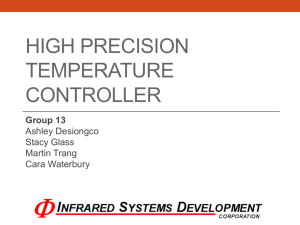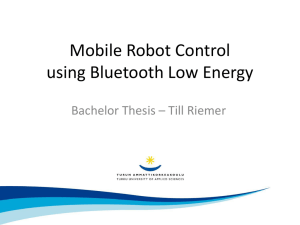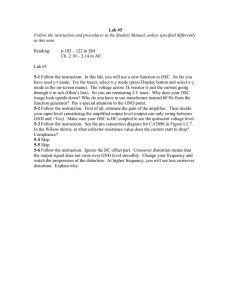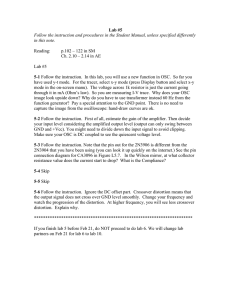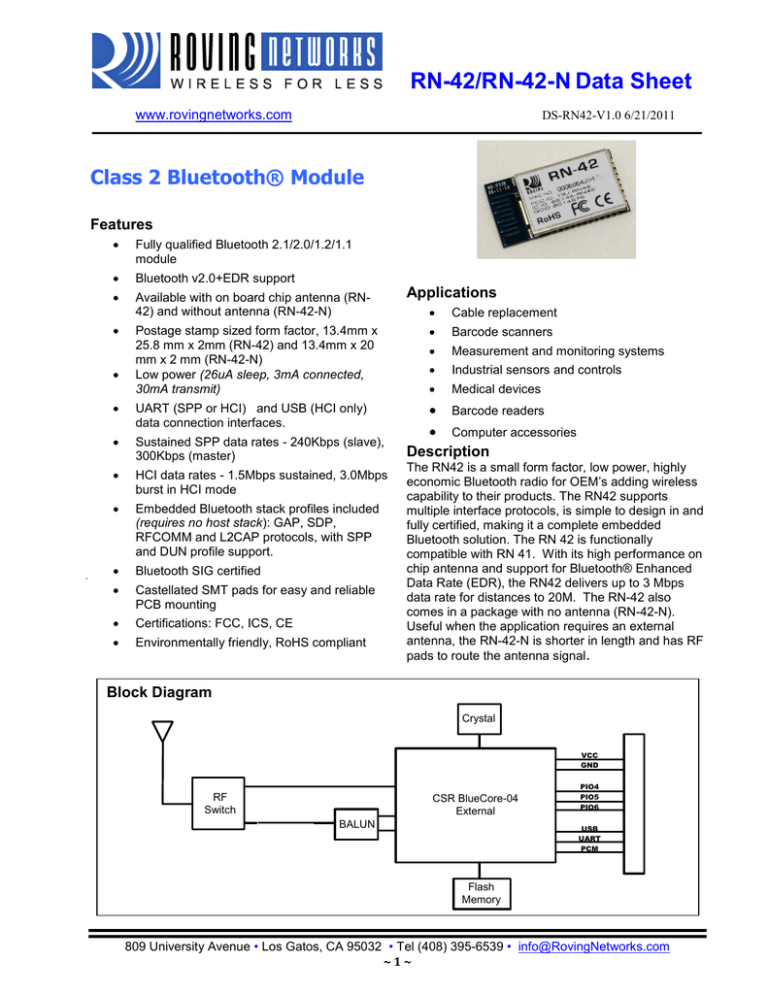
RN-42/RN-42-N Data Sheet
www.rovingnetworks.com
DS-RN42-V1.0 6/21/2011
Class 2 Bluetooth® Module
Features
Fully qualified Bluetooth 2.1/2.0/1.2/1.1
module
Bluetooth v2.0+EDR support
Available with on board chip antenna (RN42) and without antenna (RN-42-N)
Postage stamp sized form factor, 13.4mm x
25.8 mm x 2mm (RN-42) and 13.4mm x 20
mm x 2 mm (RN-42-N)
Low power (26uA sleep, 3mA connected,
30mA transmit)
UART (SPP or HCI) and USB (HCI only)
data connection interfaces.
Sustained SPP data rates - 240Kbps (slave),
300Kbps (master)
HCI data rates - 1.5Mbps sustained, 3.0Mbps
burst in HCI mode
Embedded Bluetooth stack profiles included
(requires no host stack): GAP, SDP,
RFCOMM and L2CAP protocols, with SPP
and DUN profile support.
Bluetooth SIG certified
Castellated SMT pads for easy and reliable
PCB mounting
Certifications: FCC, ICS, CE
Environmentally friendly, RoHS compliant
Applications
Cable replacement
Barcode scanners
Measurement and monitoring systems
Industrial sensors and controls
Medical devices
Barcode readers
Computer accessories
Description
The RN42 is a small form factor, low power, highly
economic Bluetooth radio for OEM’s adding wireless
capability to their products. The RN42 supports
multiple interface protocols, is simple to design in and
fully certified, making it a complete embedded
Bluetooth solution. The RN 42 is functionally
compatible with RN 41. With its high performance on
chip antenna and support for Bluetooth® Enhanced
Data Rate (EDR), the RN42 delivers up to 3 Mbps
data rate for distances to 20M. The RN-42 also
comes in a package with no antenna (RN-42-N).
Useful when the application requires an external
antenna, the RN-42-N is shorter in length and has RF
pads to route the antenna signal.
Block Diagram
Crystal
VCC
GND
RF
Switch
CSR BlueCore-04
External
PA
BALUN
PIO4
PIO5
PIO6
USB
UART
PCM
Flash
Memory
809 University Avenue • Los Gatos, CA 95032 • Tel (408) 395-6539 • info@RovingNetworks.com
~1~
RN-42/RN-42-N Data Sheet
www.rovingnetworks.com
DS-RN42-V3.2 6/21/2011
Overview
Baud rate speeds: 1200bps up to 921Kbps, non-standard baud rates can be programmed.
Class 2 radio, 60 feet (20meters) distance, 4dBm output transmitter, -80dBm typical receive sensitivity
Frequency 2402 ~ 2480MHz,
FHSS/GFSK modulation, 79 channels at 1MHz intervals
Secure communications, 128 bit encryption
Error correction for guaranteed packet delivery
UART local and over-the-air RF configuration
Auto-discovery/pairing requires no software configuration (instant cable replacement).
Auto-connect master, IO pin (DTR) and character based trigger modes
Digital I/O Characteristics
2.7V ≤ VDD ≤ 3.0V
Input logic level LOW
Input logic level HIGH
Output logc level LOW
Output logic level HIGH
All I/O’s (except reset) default to weakpull down
Min
-0.4
0.7VDD
VDD-0.2
+0.2
Typ.
+1.0
Max.
+0.8
VDD+0.4
0.2
+5.0
Unit
V
V
V
V
uA
Environmental Conditions
Parameter
Temperature Range (Operating)
Temperature Range (Storage)
Relative Humidity (Operating)
Relative Humidity (Storage)
Value
o
o
-40 C ~ 85 C
o
o
-40 C ~ 85 C
90%
90%
Electrical Characteristics
Parameter
Supply Voltage (DC)
Min
3.0
Typ.
3.3
Max.
3.6
Unit
V
Average power consumption
Radio ON* (Discovery or Inquiry
window time)
Connected Idle (No Sniff)
Connected Idle (Sniff 100 milli secs)
Connected with data transfer
Deep Sleep Idle mode
40
40
mA
25
12
45
26
mA
mA
mA
uA
50
* If in SLAVE mode there are bursts of radio ON time which vary with the windows. Depending on how you set
the windows that determines your average current.
809 University Avenue • Los Gatos, CA 95032 • Tel (408) 395-6539 • info@RovingNetworks.com
~2~
RN-42/RN-42-N Data Sheet
www.rovingnetworks.com
DS-RN42-V3.2 6/21/2011
Radio Characteristics
Parameter
Sensitivity @ 0.1%BER
RF Transmit Power
Initial Carrier Frequency
Tolerance
Freq.
(GHz)
2.402
2.441
2.480
2.402
2.441
2.480
2.402
2.441
2.480
20dB bandwidth for modulated
carrier
Drift (Five slots packet)
Drift Rate
∆f1avg Max Modulation
∆f2avg Min Modulation
2.402
2.441
2.480
2.402
2.441
2.480
Bluetooth
Specification
Min
Typ
Max
0
0
0
-
-80
-80
-80
2
2
2
5
5
5
-86
-86
-86
4
4
4
75
75
75
-
900
1000
≤ 1000
kHz
140
140
140
140
140
140
15
13
165
165
165
190
190
190
175
175
175
-
40
20
kHz
kHz
kHz
kHz
kHz
kHz
kHz
kHz
≤ -70
≤4
75
>140
115
Units
dBm
dBm
dBm
dBm
dBm
dBm
kHz
kHz
kHz
Range Characteristics (Approximate range in office environment)
Range
RN-42
After One Wall
55 feet
After Two Walls
60 feet
After Three Walls
36 feet
The above readings are approximate and may vary depending upon the RF environment. Bluetooth hops in a
pseudo-random fashion over the 79 frequencies in the ISM band to adapt to the interference. Data throughput
and range vary depending on the RF interference environment.
809 University Avenue • Los Gatos, CA 95032 • Tel (408) 395-6539 • info@RovingNetworks.com
~3~
RN-42/RN-42-N Data Sheet
www.rovingnetworks.com
DS-RN42-V3.2 6/21/2011
24
SPI_MISO
SPI MOSI
2
23
SPI_CSB
PIO6
22
3
SPI_MOSI
PIO4
GND
1
RF PAD
GND
GND
Pin Description
GND
1
24
SPI_MOSI
SPI_MISO
SPI MOSI
2
23
SPI_CSB
PIO6
3
22
PIO4
PIO7
4
21
PIO5
RESET
5
20
PIO3
SPI_CLOCK
6
19
PIO2
18
USB_D-
27 26 25
21
PIO5
RESET
5
20
PIO3
SPI_CLOCK
6
19
PIO2
PCM_CLK
7
18
USB_D-
PCM_CLK
7
PCM_SYNC
8
17
USB_D+
PCM_SYNC
8
17
USB_D+
PCM_IN
9
16
UART_CTS
PCM_IN
9
16
UART_CTS
PCM_OUT
10
15
UART_RST
UART_RTS
PCM_OUT
10
UART_RST
15 UART_RTS
VDD
11
14
UART_TX
VDD
11
14
UART_TX
GND
12
13
UART_RX
GND
12
13
UART_RX
Pin
Name
1
2
3
GND
SPI MOSI
PIO6
4
5
6
7
8
9
10
11
12
13
14
PIO7
RESET
SPI_CLK
PCM_CLK
PCM_SYNC
PCM_IN
PCM_OUT
VDD
GND
UART_RX
UART_TX
15
16
17
18
19
20
21
22
23
24
25
26
27
30
31
32
33
34
35
UART_RTS
UART_CTS
USB_D+
USB_DPIO2
PIO3
PIO5
PIO4
SPI_CSB
SPI_MISO
GND
RF Pad
GND
AIO0
PIO8
PIO9
PIO10
PIO11
AIO1
Description
AIO0
GND
PIO8
PIO9
PIO10
PIO11
GND
35 29 34 33 32 31 28 30
AIO1
AIO0
GND
PIO8
PIO9
PIO10
PIO11
GND
AIO1
35 29 34 33 32 31 28 30
RN-42-N
4
RN-42
PIO7
Default
Voltage
0V
3V
0V-3.3V
Programming only
Set BT master (HIGH=auto-master mode)
Set Baud rate (HIGH = force 9600, LOW = 115K
or firmware setting)
Active LOW reset
Programming only
PCM interface
PCM interface
PCM interface
PCM interface
3.3V regulated power input
No Connect
Input to RN42with weak pulldown
Input to RN42 with weak pulldown
Input to RN42 with 1K pullup
No Connect
No Connect
No Connect
No Connect
No Connect
0V-3.3V
UART receive Input
UART transmit output
UART RTS, goes HIGH to disable host
transmitter
UART CTS, if set HIGH, disables transmitter
USB port
USB port
Status, HIGH when connected, LOW otherwise
Auto discovery = HIGH
Status, toggles based on state, LOW on connect
Set factory defaults
Programming only
Programming only
GND for RN42-N
RF Pad for RN42-N
GND for RN42-N
Optional analog input
Status (RF data rx/tx)
IO
IO (remote DTR signal)
IO (remote RTS signal )
Optional analog input
Input to RN42
High level output from RN42
0V-3.3V
0V-3.3V
Low level output from RN42
Low level input to RN42
Pull up 1.5K when active
0V-3.3V
0V-3.3V
0V-3.3V
0V-3.3V
0V-3.3V
0V-3.3V
0V-3.3V
0V-3.3V
Output from RN42
Input to RN42 with weak pulldown
Output from RN42
Input to RN42 with weak pulldown
No Connect
No Connect
Not Used
Output from RN42
Input to RN42 with weak pulldown
Input to RN42 with weak pulldown
Input to RN42 with weak pulldown
Not Used
0V-3.3V
0V-3.3V
0V-3.3V
0V-3.3V
809 University Avenue • Los Gatos, CA 95032 • Tel (408) 395-6539 • info@RovingNetworks.com
~4~
RN-42/RN-42-N Data Sheet
www.rovingnetworks.com
DS-RN42-V3.2 6/21/2011
Typical Application Circuit
Since the RN 41 and RN 42 are functionally compatible, this application diagram applies to RN 41 and RN 42.
809 University Avenue • Los Gatos, CA 95032 • Tel (408) 395-6539 • info@RovingNetworks.com
~5~
RN-42/RN-42-N Data Sheet
www.rovingnetworks.com
DS-RN42-V3.2 6/21/2011
RN-42 Module Dimensions
NOTE: All dimensions are in mm
809 University Avenue • Los Gatos, CA 95032 • Tel (408) 395-6539 • info@RovingNetworks.com
~6~
RN-42/RN-42-N Data Sheet
www.rovingnetworks.com
DS-RN42-V3.2 6/21/2011
RN-42-N Module Dimensions
NOTE: All dimensions are in mm
809 University Avenue • Los Gatos, CA 95032 • Tel (408) 395-6539 • info@RovingNetworks.com
~7~
RN-42/RN-42-N Data Sheet
www.rovingnetworks.com
DS-RN42-V3.2 6/21/2011
Design Concerns
1. Reset circuit. RN-42 contains a weak pullup to VCC, the polarity of reset on the RN42 is ACTIVE LOW.
A power on reset circuit with delay is OPTIONAL on the reset pin of the module. It should only be required
if the input power supply has a very slow ramp, or tends to bounce or have instability on power up. Often
a microcontroller or embedded CPU IO is available to generate reset once power is stable. If not, there
are many low cost power supervisor chips available, such as MCP809, MCP102/121, and Torex XC61F.
2. Factory reset PIO4. It is a good idea to connect this pin to a switch, or jumper, or resistor, so it can be
accessed. This pin can be used to reset the module to FACTORY DEFAULTS and is often critical in
situations where the module has been mis-configured. To set Factory defaults start HIGH, then toggle two
times.
3. Connection status. PIO5 is available to drive an LED, and blinks at various speeds to indicate status.
PIO2 is an output which directly reflects the connection state, it goes HIGH when connected, and LOW
otherwise.
4. HCI mode. The RN42 module must be loaded with special firmware to run in HCI mode. When in HCI
mode the standard SPP/DUN applications are disabled.
5. Using SPI bus for flash upgrade. While not required, this bus is very useful for configuring advanced
parameters of the Bluetooth modules, and is required for upgrading the firmware on modules. The
suggested ref-design shows a 6pin header which can be implemented to gain access to this bus. A
minimum-mode version could just use the SPI signals (4pins) and pickup ground and VCC from elsewhere
on the design.
6. Minimizing Radio interference. When laying out the carrier board for the RN42 module the areas under
the antenna and shielding connections should not have surface traces, GND planes, or exposed vias.
(See diagram to right) For optimal radio performance the antenna end of RN42 module should protrude
5mm past any metal enclosure.
809 University Avenue • Los Gatos, CA 95032 • Tel (408) 395-6539 • info@RovingNetworks.com
~8~
RN-42/RN-42-N Data Sheet
www.rovingnetworks.com
DS-RN42-V3.2 6/21/2011
7. Antenna Design. The pattern from the rf_out terminal pad should be
designed with 50ohms impedance and traced with straight lines. (see
diagram to the right) The rf_out signal line should not run under of near the
RN21 module. The GND plane should be on the side of the PCB which the
module is mounted. The GND should be reinforced with through-hole
connections and other means to stabilize the electric potential.
GND
RF_OUT
GND
RN21 Module
8. Soldering Reflow Profile.
Lead-Free Solder Reflow
Temp: 230 degree C, 30-40 seconds, Peak 250 degree C maximum.
Preheat temp: 165 +- 15 degree C, 90 to 120 seconds.
Time: Single Pass, One Time
Compliance Information
Category
Country
USA
FCC ID:
Radio
EUROPE
CANADA
Certification Number:
USA
EUROPE
EMC
Bluetooth
Environmental
BQB LISTED
RoHS
Standard
FCC Part 15 Subpart B: 2008 Class B
FCC CRF Title 47 Part 15 Subpart C
T9J-RN42
ETSI EN 301 489-1 V1.8.1
ETSI EN 301 489-17 V2.1.1
ETSI EN 300 328 V1.7.1
IC RSS-210 low power comm. device
6514A-RN42
FCC CFR47 Part 15 subclass B
EN 55022 Class B radiated
EN61000-4-2 ESD immunity
EN61000-4-3 radiated field
EN61000-4-6 RF immunity
EN61000-4-8 power magnetic immunity
B014867- SPP and DUN profiles
RoHS compliant
Ordering Information
Part Number
RN-42
RN-42-H
RN-42-U
RN-42-N
Description
Standard Application firmware (SPP/DUN Master and Slave)
HCI firmware (HCI over H4 UART)
USB firmware (HCI over USB port, slave device at 12Mbps rate)
No Antenna, Standard Application firmware (SPP/DUN Master and Slave)
For other configurations, contact Roving Networks directly.
Visit http://www.rovingnetworks.com/buynow.php for current pricing and a list of distributors carrying
our products.
809 University Avenue • Los Gatos, CA 95032 • Tel (408) 395-6539 • info@RovingNetworks.com
~9~
RN-42/RN-42-N Data Sheet
www.rovingnetworks.com
DS-RN42-V3.2 6/21/2011
Copyright © 2011 Roving Networks. All rights reserved.
The Bluetooth trademark and logo are registered trademarks and are owned by the Bluetooth SIG, Inc. All
other trademarks are property of their respective owners.
Roving Networks reserves the right to make corrections, modifications, and other changes to its products,
documentation and services at any time. Customers should obtain the latest relevant information before
placing orders and should verify that such information is current and complete.
Roving Networks assumes no liability for applications assistance or customer product design. Customers are
responsible for their products and applications using Roving Networks components. To minimize the risks
associated with customer products and applications, customers should provide adequate design and operating
safeguards.
Roving Networks products are not authorized for use in safety-critical applications (such as life support) where
a failure of the Roving Networks product would reasonably be expected to cause severe personal injury or
death, unless officers of the parties have executed an agreement specifically governing such use.
809 University Avenue • Los Gatos, CA 95032 • Tel (408) 395-6539 • info@RovingNetworks.com
~ 10 ~




